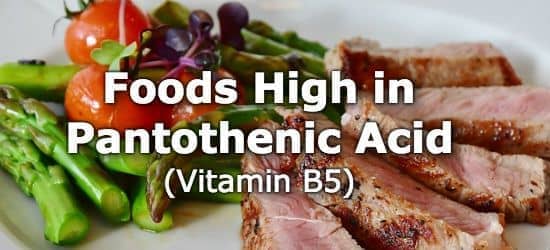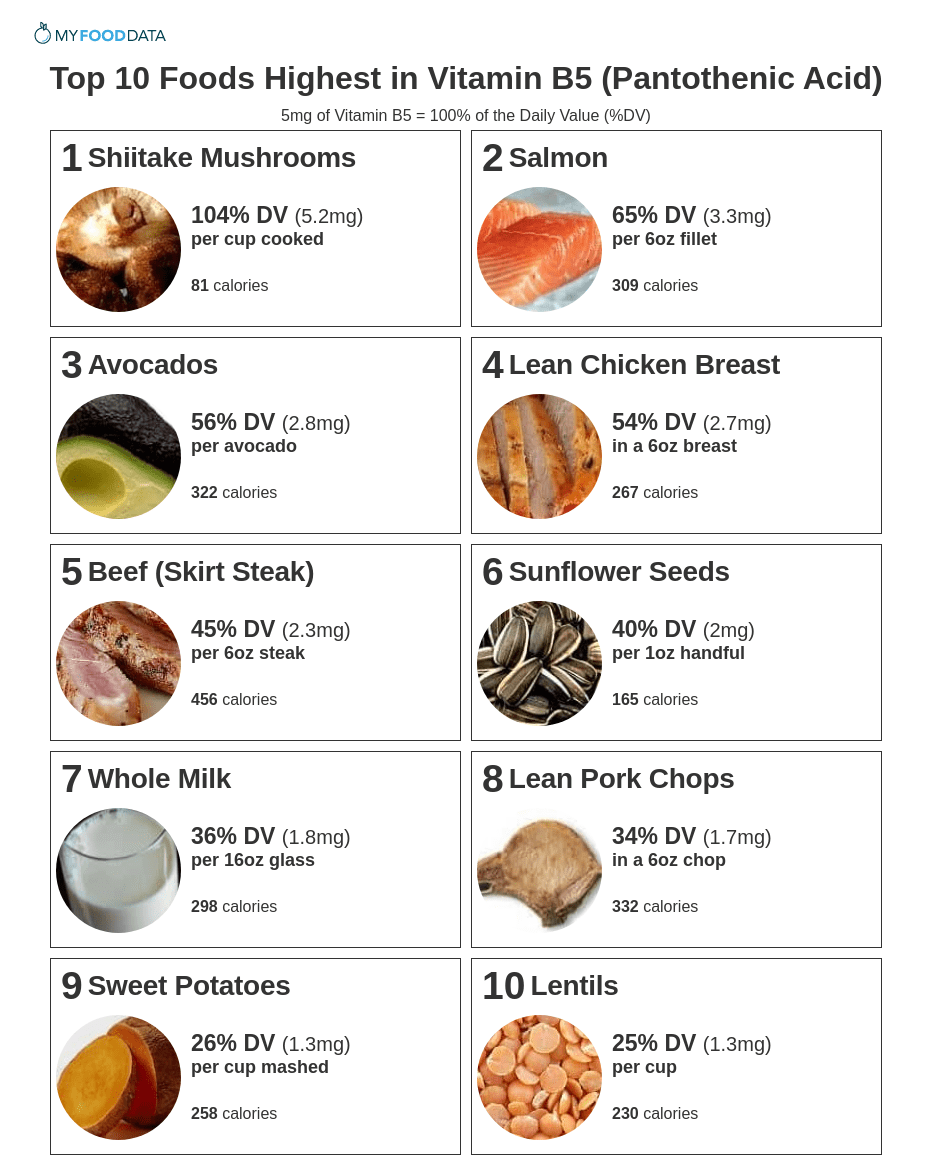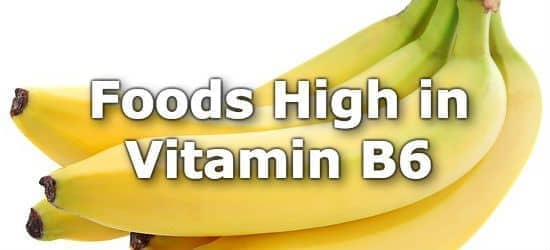Top 10 Foods Highest in Vitamin B5 (Pantothenic Acid)

Vitamin B5, or Pantothenic Acid, is an essential vitamin required by the body for producing energy from carbohydrates and fats, creating certain neurotransmitters and hormones, and making red blood cells. (1)
A deficiency of vitamin B5 is rare, but may increase the risk of neurodegenerative diseases like Alzheimer's disease. (1,2)
Vitamin B5 is a water-soluble vitamin. This makes it easy for the body to eliminate any excess, so overdose is rare. In general, it will only cause minor symptoms, like diarrhea or other digestive disturbances. (3,4)
Foods high in vitamin B5 include mushrooms, fish, avocados, eggs, lean chicken, beef, pork, sunflower seeds, milk, sweet potatoes, and lentils. The current daily value (DV) for Pantothenic Acid (vitamin B5) is 5mg. (5)
Below is a list of high vitamin B5 foods ranked by a common serving size. See the nutrient ranking of all foods high in vitamin B5 to sort by 100 gram serving sizes.
-
 1. Shiitake Mushrooms
1. Shiitake Mushrooms
Vitamin B5
per Cup CookedVitamin B5
per 100gVitamin B5
per 200 Calories5.2mg
(104% DV)3.6mg
(72% DV)12.8mg
(257% DV)More Mushrooms High in Vitamin B5
- 67% DV in 1 cup of button mushrooms
- 31% DV in 1 cup of portabella mushrooms
- 26% DV in 1 cup of crimini (chestnut) mushrooms
See all vegetables high in vitamin B5.
-
 2. Salmon
2. Salmon
Vitamin B5
per 6oz FilletVitamin B5
per 100gVitamin B5
per 200 Calories3.3mg
(65% DV)1.9mg
(38% DV)2.1mg
(42% DV)More Fish High in Vitamin B5
- 47% DV in a 6oz tuna fillet
- 30% DV in a 5oz trout fillet
- 30% DV in a 6oz snapper fillet
See all fish high in vitamin B5.
-
3. Avocados
Vitamin B5
per AvocadoVitamin B5
per 100gVitamin B5
per 200 Calories2.8mg
(56% DV)1.4mg
(28% DV)1.7mg
(35% DV)More Fruits High in Vitamin B5
- 15% DV in 1 cup of guavas
- 13% DV in 1 cup of grapefruit sections
- 10% DV in 1 cup of sliced bananas
See all fruits high in vitamin B5.
-
 4. Lean Chicken Breast
4. Lean Chicken Breast
Vitamin B5
in a 6oz BreastVitamin B5
per 100gVitamin B5
per 200 Calories2.7mg
(54% DV)1.6mg
(32% DV)2mg
(40% DV)More Poultry High in Vitamin B5
- 34% DV in a chicken thigh
- 33% DV in 6oz of ground turkey
- 23% DV in a chicken drumstick
See all meats high in vitamin B5.
-
 5. Beef (Skirt Steak)
5. Beef (Skirt Steak)
Vitamin B5
per 6oz SteakVitamin B5
per 100gVitamin B5
per 200 Calories2.3mg
(45% DV)1.3mg
(27% DV)1mg
(20% DV)More Red Meat High in Vitamin B5
- 23% DV in a 3oz buffalo steak
- 14% DV in a 3oz beef hamburger
- 12% DV in 3oz of lamb shank
See all meats high in vitamin B5.
-
 6. Sunflower Seeds
6. Sunflower Seeds
Vitamin B5
per 1oz HandfulVitamin B5
per 100gVitamin B5
per 200 Calories2mg
(40% DV)7mg
(141% DV)2.4mg
(48% DV) -
 7. Whole Milk
7. Whole Milk
Vitamin B5
per 16oz GlassVitamin B5
per 100gVitamin B5
per 200 Calories1.8mg
(36% DV)0.4mg
(7% DV)1.2mg
(24% DV)More Dairy High in Vitamin B5
- 36% DV in a 16oz glass of non-fat or skim milk
- 29% DV in 1 cup of low-fat yogurt
- 19% DV in 1 cup of buttermilk
See all dairy foods high in vitamin B5.
-
 8. Lean Pork Chops
8. Lean Pork Chops
Vitamin B5
in a 6oz ChopVitamin B5
per 100gVitamin B5
per 200 Calories1.7mg
(34% DV)1mg
(20% DV)1mg
(21% DV)More Pork High in Vitamin B5
- 20% DV in 1 cup of ham
- 18% DV in 3oz of salami
- 17% DV in 3oz of pork tenderloin
See all meats high in vitamin B5.
-
 9. Sweet Potatoes
9. Sweet Potatoes
Vitamin B5
per Cup MashedVitamin B5
per 100gVitamin B5
per 200 Calories1.3mg
(26% DV)0.5mg
(10% DV)1mg
(20% DV)More Vegetables High in Vitamin B5
- 27% DV in 1 cup of podded peas
- 24% DV in 1 cup of yellow sweet corn
- 21% DV in 1 cup of baked acorn squash
See all vegetables high in vitamin B5.
-
 10. Lentils
10. Lentils
Vitamin B5
per CupVitamin B5
per 100gVitamin B5
per 200 Calories1.3mg
(25% DV)0.6mg
(13% DV)1.1mg
(22% DV)More Legumes High in Vitamin B5
- 23% DV in 1 cup of split peas
- 16% DV in 1 cup of lima beans
- 14% DV in 1 cup of black-eyed peas
Printable One Page Sheet

Pantothenic Acid (B5) Requirements By Age and Gender
The adequate intakes (AI) for pantothenic acid (B5) range from 1.7mg to 7mg per day. The daily value for vitamin B5 is 5mg per day. (5)
| Life Stage | AI |
|---|---|
| Infants | |
| 0-6 months old | 1.7mg |
| 7-12 months old | 1.8mg |
| Children | |
| 1-3 years old | 2mg |
| 4-8 years old | 3mg |
| Males | |
| 9-13 years old | 4mg |
| 14-18 years old | 5mg |
| 19-50 years old | 5mg |
| 50+ years old | 5mg |
| Females | |
| 9-13 years old | 4mg |
| 14-18 years old | 5mg |
| 19-50 years old | 5mg |
| 50+ years old | 5mg |
| Pregnancy | |
| 14-18 years old | 6mg |
| 18+ years old | 6mg |
| Lactation | |
| 14-18 years old | 7mg |
| 18+ years old | 7mg |
Other Vitamin B Foods
About the Data
Data for the curated food lists comes from the USDA Food Data Central Repository.
You can check our data against the USDA by clicking the (Source) link at the bottom of each food listing.
Note: When checking data please be sure the serving sizes are the same. In the rare case you find any difference, please contact us and we will fix it right away.
About Nutrient Targets
Setting targets can provide a guide to healthy eating.
Some of the most popular targets include:- Daily Value (%DV) - The daily value (%DV) is a general guideline for consumption that will prevent deficiency of a particular nutrient in most people. The %DV refers to the percentage of an amount that\'s found in a single serving of a food. It also accounts for absorption factors. It is set by the U.S. FDA.
- Recommended Dietary Allowance (%RDA) - The RDA sets an average daily dietary intake level that is sufficient to meet the nutrient requirements of nearly all (97.5%) healthy individuals. It\'s more specific than the daily value, and varies by age and gender. The RDA is set by the US National Institutes of Health.
- Reference Dietary Intake (%RDI) -The reference dietary intake is similar to the recommended daily allowance, but is specific to age and gender. The RDI for amino acids is set by the U.N. World Health Organization.
- Adequate Intake (%AI) - This value is primarily used in reference to omega-3 and omega-6 fats. The Adequate Intake is set by the U.S. Institute of Medicine. Because there is less evidence to determine the ideal targets for consumption of these nutrients, the specific amount is considered to be less reliable. Using the term Adequate Intake, rather than one of the other terms, helps to emphasize that the ideal intake of that particular nutrient has not yet been scientifically determined.
See the Guide to Recommended Daily Intakes for more information.
Want to set your own targets? Sign up for an account and set custom targets in the daily food log.From the Nutrient Ranking Tool
Use the ranking tool links below to select foods and create your own food list to share or print.
- Foods High in Pantothenic acid (B5)
- Foods Low in Pantothenic acid (B5)
- Vegetables High in Pantothenic acid (B5)
- Fruits High in Pantothenic acid (B5)
- Vegetarian Foods High in Pantothenic acid (B5)
- Nuts High in Pantothenic acid (B5)
- Beans High in Pantothenic acid (B5)
- Dairy High in Pantothenic acid (B5)
- Breakfast Cereals High in Pantothenic acid (B5)
- Fast Foods High in Pantothenic acid (B5)
View more nutrients with the nutrient ranking tool, or see ratios with the nutrient ratio tool.
Related
Data Sources and References
- Pantothenic acid in health and disease
- Ismail N, Kureishy N, Church SJ, Scholefield M, Unwin RD, Xu J, Patassini S, Cooper GJS. Cerebral deficiency of vitamin B5 (d-pantothenic acid; pantothenate) as a potentially-reversible cause of neurodegeneration and dementia in sporadic Alzheimer's disease Biochem Biophys Res Commun. 2020 Jan 29;522(1):220-225. doi: 10.1016/j.bbrc.2019.11.052. Epub 2019 Nov 20. 31759626
- Konings EJ; Committee on Food Nutrition. Biochemistry, Water Soluble Vitamins J AOAC Int. 2006 Jan-Feb;89(1):285-8. 16512258
- Xu J, Patassini S, Begley P, Church S, Waldvogel HJ, Faull RLM, Unwin RD, Cooper GJS. Cerebral Vitamin B5 (D-Pantothenic Acid) Deficiency as a Potential Cause of Metabolic Perturbation and Neurodegeneration in Huntington's Disease Biochem Biophys Res Commun. 2020 Jun 30;527(3):676-681. doi: 10.1016/j.bbrc.2020.05.015. Epub 2020 May 4. 32416962
- U.S.FDA - Daily Value on the New Nutrition and Supplement Facts Labels
Try the recipe nutrition calculator, or daily meal planner.
Create a free account to log and track foods.


 Next ➞
Next ➞